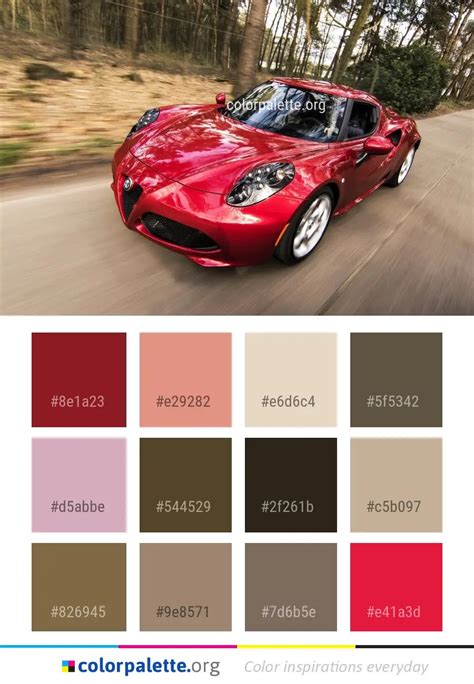
## Color Palette for Cars: A Journey Through Visual Appeal and Brand Identity
In the realm of automotive design, color occupies a central role, captivating the attention of car enthusiasts and shaping the overall perception of a vehicle's character. From the first brushstrokes of concept sketches to the gleaming finish of a showroom model, color palettes play a pivotal role in defining a car's identity and reflecting the aspirations of its drivers.
### The Psychology of Color in Automotive DesignColors possess an innate ability to evoke emotions and associations, creating powerful psychological effects on the viewer. In the context of car design, color choices can influence perceptions of a vehicle's personality, performance, and safety. For instance, red is often associated with excitement, passion, and speed, while blue conveys a sense of calm, reliability, and sophistication. Understanding these psychological associations allows designers to harness the expressive power of color to align a vehicle's visual identity with its intended audience.
### Cultural and Regional PreferencesColor preferences for cars vary across cultures and regions, reflecting diverse aesthetic sensibilities and cultural norms. In some parts of the world, neutral colors like black, white, and silver dominate the automotive landscape, while in other regions, vibrant hues like red, yellow, and blue are more prevalent. These preferences are influenced by various factors such as climate, geography, and historical traditions. For example, in sunnier climates, lighter colors are often chosen to reflect sunlight and reduce heat absorption, while in colder regions, darker colors are preferred for their ability to absorb heat and provide a sense of warmth.
### Brand Identity and Color AssociationColor plays a crucial role in establishing and reinforcing brand identity in the automotive industry. Car manufacturers carefully select color palettes that align with their brand's values, personality, and target audience. For instance, luxury brands like Mercedes-Benz and BMW often employ elegant and understated colors such as black, silver, and navy blue to convey a sense of prestige and sophistication. In contrast, brands targeting a younger and more adventurous demographic, such as Jeep and MINI, frequently utilize bold and vibrant colors like red, yellow, and green to evoke excitement and individuality.
### Color Trends and Seasonal InfluencesThe automotive color palette is a dynamic landscape, constantly evolving to reflect changing consumer preferences and design trends. Each year, leading automotive paint suppliers release their color trend forecasts, showcasing the latest hues and finishes that are expected to dominate the upcoming season. These trends are influenced by various factors, including fashion, art, and popular culture. For example, the rise of eco-consciousness has led to an increased demand for sustainable and environmentally friendly colors, such as earthy tones and muted greens. Additionally, the popularity of electric and autonomous vehicles has inspired designers to explore futuristic color combinations that reflect the transformative nature of these technologies.
### Color and SafetyIn addition to aesthetic considerations, color also plays a significant role in vehicle safety. Bright and contrasting colors can enhance visibility, making a vehicle more noticeable to other road users. For this reason, many emergency vehicles, such as fire trucks and ambulances, utilize highly visible colors like red, yellow, and orange. Furthermore, the use of reflective pigments and finishes can further improve a vehicle's visibility, especially in low-light conditions.
### The Future of Automotive Color PalettesAs the automotive industry continues to evolve, the role of color in car design is likely to become even more multifaceted. With the advent of advanced manufacturing techniques and innovative materials, designers have access to a wider range of color options than ever before. Additionally, the increasing popularity of personalization and customization allows consumers to express their individuality by selecting unique color combinations and finishes that reflect their personal style.
### ConclusionThe color palette for cars is a captivating tapestry of art, psychology, and cultural influences, shaping the visual identity of vehicles and evoking emotions in drivers and onlookers alike. As the automotive industry continues to push the boundaries of design and technology, the role of color will undoubtedly remain a central element in defining the future of automotive aesthetics.